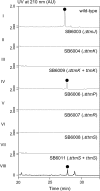Characterization of the tautomycin biosynthetic gene cluster from Streptomyces spiroverticillatus unveiling new insights into dialkylmaleic anhydride and polyketide biosynthesis
- PMID: 18708355
- PMCID: PMC2568922
- DOI: 10.1074/jbc.M804279200
Characterization of the tautomycin biosynthetic gene cluster from Streptomyces spiroverticillatus unveiling new insights into dialkylmaleic anhydride and polyketide biosynthesis
Abstract
Tautomycin (TTM) is a highly potent and specific protein phosphatase inhibitor isolated from Streptomyces spiroverticillatus. The biological activity of TTM makes it an important lead for drug discovery, whereas its spiroketal-containing polyketide chain and rare dialkylmaleic anhydride moiety draw attention to novel biosynthetic chemistries responsible for its production. To elucidate the biosynthetic machinery associated with these novel molecular features, the ttm biosynthetic gene cluster from S. spiroverticillatus was isolated and characterized, and its involvement in TTM biosynthesis was confirmed by gene inactivation and complementation experiments. The ttm cluster was localized to a 86-kb DNA region, consisting of 20 open reading frames that encode three modular type I polyketide synthases (TtmHIJ), one type II thioesterase (TtmT), five proteins for methoxymalonyl-S-acyl carrier protein biosynthesis (Ttm-ABCDE), eight proteins for dialkylmaleic anhydride biosynthesis and regulation (TtmKLMNOPRS), as well as two additional regulatory proteins (TtmF and TtmQ) and one tailoring enzyme (TtmG). A model for TTM biosynthesis is proposed based on functional assignments from sequence analysis, which agrees well with previous feeding experiments, and has been further supported by in vivo gene inactivation experiments. These findings set the stage to fully investigate TTM biosynthesis and to biosynthetically engineer new TTM analogs.
Figures






Similar articles
-
Characterization of the tautomycetin biosynthetic gene cluster from Streptomyces griseochromogenes provides new insight into dialkylmaleic anhydride biosynthesis.J Nat Prod. 2009 Mar 27;72(3):450-9. doi: 10.1021/np8007478. J Nat Prod. 2009. PMID: 19191560 Free PMC article.
-
Utilization of the methoxymalonyl-acyl carrier protein biosynthesis locus for cloning of the tautomycin biosynthetic gene cluster from Streptomyces spiroverticillatus.J Bacteriol. 2006 Jun;188(11):4148-52. doi: 10.1128/JB.00172-06. J Bacteriol. 2006. PMID: 16707708 Free PMC article.
-
Functional characterization of ttmM unveils new tautomycin analogs and insight into tautomycin biosynthesis and activity.Org Lett. 2009 Apr 2;11(7):1639-42. doi: 10.1021/ol900293j. Org Lett. 2009. PMID: 19281218 Free PMC article.
-
Biosynthesis, regulation, and engineering of a linear polyketide tautomycetin: a novel immunosuppressant in Streptomyces sp. CK4412.J Ind Microbiol Biotechnol. 2017 May;44(4-5):555-561. doi: 10.1007/s10295-016-1847-2. Epub 2016 Oct 12. J Ind Microbiol Biotechnol. 2017. PMID: 27734184 Review.
-
Natural products with maleic anhydride structure: nonadrides, tautomycin, chaetomellic anhydride, and other compounds.Chem Rev. 2007 May;107(5):1777-830. doi: 10.1021/cr050029r. Epub 2007 Apr 18. Chem Rev. 2007. PMID: 17439289 Review. No abstract available.
Cited by
-
The biosynthetic pathway to tetromadurin (SF2487/A80577), a polyether tetronate antibiotic.PLoS One. 2020 Sep 14;15(9):e0239054. doi: 10.1371/journal.pone.0239054. eCollection 2020. PLoS One. 2020. PMID: 32925967 Free PMC article.
-
Studies on Streptomyces sp. SN-593: reveromycin biosynthesis, β-carboline biomediator activating LuxR family regulator, and construction of terpenoid biosynthetic platform.J Antibiot (Tokyo). 2022 Aug;75(8):432-444. doi: 10.1038/s41429-022-00539-1. Epub 2022 Jul 1. J Antibiot (Tokyo). 2022. PMID: 35778609 Review.
-
Characterization of the biosynthesis gene cluster for the pyrrole polyether antibiotic calcimycin (A23187) in Streptomyces chartreusis NRRL 3882.Antimicrob Agents Chemother. 2011 Mar;55(3):974-82. doi: 10.1128/AAC.01130-10. Epub 2010 Dec 20. Antimicrob Agents Chemother. 2011. PMID: 21173184 Free PMC article.
-
Chemical biology research in RIKEN NPDepo aimed at agricultural applications.Proc Jpn Acad Ser B Phys Biol Sci. 2025;101(1):8-31. doi: 10.2183/pjab.101.003. Proc Jpn Acad Ser B Phys Biol Sci. 2025. PMID: 39805590 Free PMC article. Review.
-
Identification and Predictions Regarding the Biosynthesis Pathway of Polyene Macrolides Produced by Streptomyces roseoflavus Men-myco-93-63.Appl Environ Microbiol. 2021 Apr 27;87(10):e03157-20. doi: 10.1128/AEM.03157-20. Print 2021 Apr 27. Appl Environ Microbiol. 2021. PMID: 33637575 Free PMC article.
References
-
- Cheng, X. C., Kihara, T., Kusakabe, H., Magae, J., Kobayashi, Y., Fang, R. P., Ni, Z. F., Shen, Y. C., Ko, K., Yamaguchi, I., and Isono, K. (1987) J. Antibiot. 40 907-909 - PubMed
-
- Cheng, X. C., Ubukata, M., and Isono, K. (1990) J. Antibiot. 43 809-819 - PubMed
-
- Ubukata, M., Cheng, X. C., Isobe, M., and Isono, K. (1993) J. Chem. Soc., Perkin Trans. 1 5 617-624
-
- Ubukata, M., Cheng, X. C., and Isono, K. (1990) Chem. Comm. 3 244-246
-
- Cheng, X. C., Kihara, T., Ying, X., Uramoto, M., Osada, H., Kusakabe, H., Wang, B. N., Kobayashi, Y., Ko, K., Yamaguchi, I., Shen, Y. C., and Isono, K. (1989) J. Antibiot. 42 141-144 - PubMed
Publication types
MeSH terms
Substances
Grants and funding
LinkOut - more resources
Full Text Sources
Other Literature Sources

